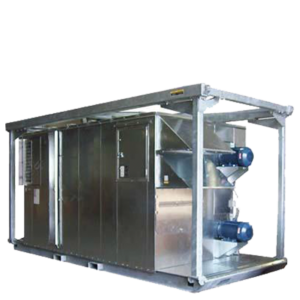HOLDING THE BLAST – THROUGH DEHUMIDIFICATION
Recently we had a customer that was needing to “hold the blast” on a structure that he was blasting and painting. This is typical when you are doing large tank projects, as it allows you to completely blast the tank, clean up once and then paint.
What you are trying to control is the atmospheric Relative Humidity (RH) inside the tank. This measurement is calculated as a percentage, and, in order to “hold the blast” you need the RH to be below 50%. That’s really where the size of your DH unit matters.
In this application you’re trying to protect steel because it’s bare after being blasted. If you turn the air over in that space 2-4 times an hour through a Dehumidifier, it’s going to be fine. In preparation for painting, keeping the relative humidity low enough in that space (provided it’s controlled and not opened to the atmosphere for an extended period of time) will protect you.
Let’s put those 2-4 air changes per hour into a real-life scenario. Assume you have some sort of structure that is 30 feet X 25 feet X 20 feet.
To calculate the size dehumidifier required is simple…
- Determine the cubic feet inside the enclosure, this is 30 feet X 25 feet X 20 feet and come up with 15,000 cubic feet
- Multiply by the Air Changes per hour required to keep the RH% under 50. If the containment is tight use 2-3 changes, if its loose with air-leaks, use 4 changes per hour. We can just go ahead and multiply that by 4, because we know 4 air-changes every hour will be sufficient. Take the 15,000 and multiply by 4 and you get 60,000 Cubic Feet Per Hour
- Convert Cubic Feet Per Hour to Cubic feet per minute. To get the CFM, cubic feet per minute, (which is how these machines are rated), we’re just going to divide that number by 60 (sixty minutes in an hour, right?). This comes out to 1,000. So that’s it!
A 1,000 CFM machine will turn that air in that containment over 4 times every hour.
Now, four times per hour is pretty aggressive for most areas. What you’ll find is that no matter how big the tank is, it’s probably not going to be as many CFM as what you would expect. If the space is very air-tight, you may get away with more like 2 to 3 air-changes every hour.
Dessicant vs Refrigerant
Of course, there are other considerations and limitations that you’ll need to be mindful of. As an example, there are two basic types of Dehumidifier units, one that utilizes a Desiccant wheel and the other that uses refrigerant. A Desiccant style can be used ANYTIME while the Refrigerant style cannot be used below 55F degrees.
Let’s talk about using a refrigerant type for a second. Now, it’s a little bit different when using a refrigerant based dehumidification. Slightly different than cooling. As mentioned before, it will work down to 55F. An air conditioner typically will stop removing water at 60-65 degrees. So, if you’re in a really hot environment, and it’s going to stay hot, you could use an air conditioner to pull the moisture down. An air conditioner, if it’s sized right, will typically maintain 45% relative humidity in a given space. We can’t cool air without drying it, it’s just not possible by the nature of air. Hot air holds more water than cold air. So, if we take a volume of air and we make it colder, it physically can’t hold the water. It’s just psychrometrics.
So, if you’re in a really hot environment, say 80, 85, 90 degrees and it’s going to stay that way, it’s not going to hurt you to cool it down inside there a little bit. If an air conditioner is the closest thing to the project site, just grab an air conditioner. Just make sure that you size it right. How? You’ll want to do the same type of formula as above to calculate number of air changes. Make sure you’ve got 2-4 air changes in there. And the air condition unit – we’re not using it for cooling at this point – we’re using it for drying, it’s probably never going to satisfy the temperature. In practice, you need a lot more tonnage to cool a space than you do to dry it.
Drying is going to happen the entire time, so much so that you’re going to have water pumping out of that machine non-stop. So, you can use air conditioners for drying, however, you’ll want to be careful about the dewpoint. Check the dewpoint on your DeFelsko DPM-L logger or your hygrometer before you go blasting that tank with cold air. An AC unit is going to put out 50 to 55 degree air to make sure you check the dewpoint in the space. If the dewpoint is 60 on the steel, and we hit it with 50-degree air, the water that’s there is going to condense and it’s going to rust. So, you want to make sure that when you turn on the AC, we’re not going to hit the dewpoint.
Continuous checking of the site environmental conditions is very important and having the correct tools for the job is a big advantage.
- A simple hygrometer and the Psychrometric Charts are one way to spot check RH.
- Another much easier method is to employ the use of a data logger (DPM-L) manufactured by DeFelsko. This can be connected remotely via Bluetooth technology and spot checked using your phone as well as having data uploaded to the cloud, etc.
Other things to be mindful of are:
- applications when you are adding Dehumidification at the same time as using a Dust Collector.
- Need to keep CFM roughly equal or slightly higher
- Adding HEAT into space (especially when outside temperatures are cool/cold).
- Critical to bring temperature up slowly to avoid condensation
- Static pressure losses on long duct runs.
- Adding in-line blowers (fairly common practice)
- Best practice is to never pull a return on a tank through an AC unit unless you absolutely have to.
If you have some specific issues you are trying to resolve, or if you have some very unusual site conditions, feel free to reach out to BlastOne to get some qualified advice.
 My Account
My Account




